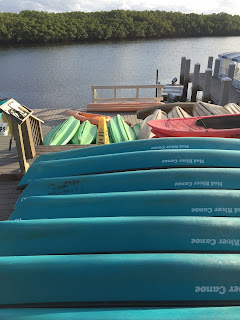Field biology continues with a two for one field trip day! We
visited the Florida Oceanographic
Society and then CSA Ocean Sciences,
Inc. in Stuart, FL.
Dr Vincent Encomio gave us an overview of his work with Oyster
restoration and Dr. Katie Tiling [former Wilkes
Honors College student and PhD alumnus from FAU]
explained her work with seagrass restoration. Both explained the concept of living
shorelines. Below is information about what we learned.
The following information has been excerpted from their website.
The Florida Oceanographic Society is leading efforts in
research, monitoring and restoring habitats in South Florida, particularly in
the southern portion of the Indian River Lagoon. The Indian River Lagoon is
North America’s most bio-diverse estuary, home to more than 4,300 species of
plants and animals, including 36 rare and endangered species.
Vincent Encomio, PhD, Research Scientist,
spearheads the effort to restore the oyster population devastated by
fresh-water discharges into the estuary that began in 2005 and continues today!
The oysters are critical to cleaning the water and providing habitat and food
for up to 300 estuarine species.
The FL.O.O.R. (Florida Oceanographic Oyster
Restoration) program actively engages the public in restoring oyster reef
habitat. With the aid of thousands of volunteers, FL.O.O.R. restores oyster
habitat by recycling shell, constructing reefs and growing oysters.
F.O.S.T.E.R.’s
goal is to restore seagrass populations into our estuary impacted by
fresh-water discharges and algal blooms. Seagrasses are vital to the health of
Florida’s waterways as it provides habitat, nurseries, and food for a variety
of estuarine species. In Florida, we have the highest seagrass biodiversity of
the continental USA with seven species!
The
F.O.S.T.E.R. program relies on community-based restoration efforts to restore
seagrass habitat. With a growing volunteer base, F.O.S.T.E.R. restores seagrass
by collecting and growing seagrass fragments in nurseries, constructing
seagrass planting units, and transplanting living seagrass into the estuary.
Part two of our trip took us to CSA Ocean Sciences, Inc. Mary Jo Barkaszi, who is the Marine Mammal Programs Manager gave us a company overview and then
specifics of her work with
marine mammal acoustics.
CSA Ocean Sciences, Inc [from
their website]
CSA
Ocean Sciences Inc. (CSA) specializes in multidisciplinary projects concerning
potential environmental impacts of activities throughout the world and offers a
wide variety of desktop and field survey services. CSA is headquartered in
Stuart, Florida, with regional offices in Tampa, Florida; Houma, Louisiana;
Salinas, California; Houston, Texas; Port-of-Spain, Trinidad; Doha, Qatar; Rio
de Janeiro, Brazil and Perth, Australia.
OCEAN SOUND EXPERTISE
Ocean sound is a complex issue—CSA understands ocean sound.
Whether it is detection and classification of marine species, noise
measurement, sound propagation, predictive modeling, or soundscape
characterization; we take the approach that one size does not fit all. CSA uses
the best available science and technologies to develop risk-minimizing results
with a suite of solutions from simple to complex. Ocean sound issues are large
in scale both temporally and spatially, but also have many short-term, acute
components, which is why CSA approaches this problem at a habitat or soundscape
level. Ambient noise in the ocean will fluctuate greatly depending on both
natural and man-made contributions within a region’s soundscape. Short-term
measurements do not provide an accurate assessment of regional changes due to
cumulative variations to sound levels, but can be useful in identifying
specific contributors. To provide an accurate level of change detection,
long-term monitoring is necessary in order to quantify the contributions of
each source. At the same time, monitoring is required to ensure that the
shorter-term, acute contributions are minimized. The timing of deployment is
crucial in that the data collection occurring before, during, and after an
influx of operations will provide the greatest return on the analysis. These
acoustic data can be used to provide long-term information about the local
soundscape and the activities that presently occur and, furthermore, can be
used as a benchmark for comparison with a future soundscape.
Please
follow the links to their website to learn about everything they are doing all
over the world.
Field Trip Friday was again a huge success. It is interesting to find out what
science is going on close to campus and the resources available to the
students.


































